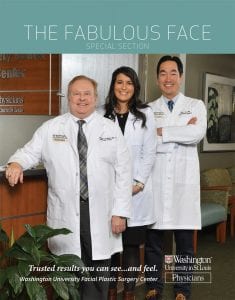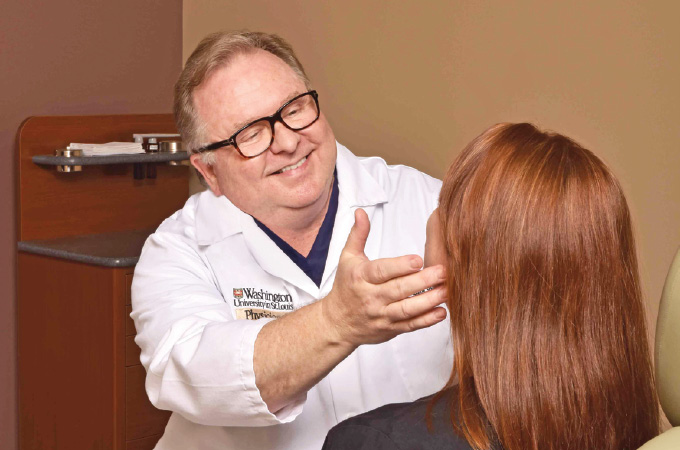If you’ve ever consulted a doctor about facial skin treatments, you probably know there are a number of ways to rejuvenate and refresh. Depending on individual needs, options include Botox for lines and wrinkles, dermal fillers to restore volume, and laser resurfacing and peels to improve texture. The choices and information available can be overwhelming, so it’s a good idea to approach the subject with educated questions and realistic goals, according to physicians at Washington University Facial Plastic Surgery Center.
“When patients first come in, we discuss what they already know and what results they are expecting,” says plastic surgeon Dr. John Chi. “We also talk about the skin as it relates to a healthy lifestyle and habits. Some people have very specific treatment requests, and others say they’re ready to have something done but aren’t sure what. We assess skin health and appearance, talk about the aging process, and prioritize needs from there.”
 Plastic surgeon Dr. Emily Spataro adds that many people get information online about different procedures, so it’s important for doctors to discuss what patients have learned and make sure there are no misconceptions. “They often see other people’s stories on social media and assume they will get the exact same results,” she says. “There’s a lot of information online, both good and bad. We make sure people have full knowledge of what actually is involved with different treatments, including outcome, downtime and cost.”
Plastic surgeon Dr. Emily Spataro adds that many people get information online about different procedures, so it’s important for doctors to discuss what patients have learned and make sure there are no misconceptions. “They often see other people’s stories on social media and assume they will get the exact same results,” she says. “There’s a lot of information online, both good and bad. We make sure people have full knowledge of what actually is involved with different treatments, including outcome, downtime and cost.”
Dr. Gregory Branham, another plastic surgeon in the practice, says the goal of facial procedures is always a natural, healthy look. To achieve the best results, it makes sense to establish a relationship with a board-certified, fellowship-trained facial plastic surgeon, he notes. “When you take care of your skin consistently, starting in young adulthood, you’ll see better results,” he says. “Good habits also will help prepare your skin if you decide to do something more involved later in life, such as a face-lift.”
Chi says facial rejuvenation success can be measured not just in terms of appearance, but in how the skin feels. “When patients touch their faces after a peel or laser resurfacing, they actually are feeling new skin brought to the surface,” he explains. “It’s an interesting sensory experience. Patients really notice the texture change and say they feel refreshed.” Spataro adds, “Studies have shown that there is a real emotional response to rejuvenated skin, especially when patients look at before and after images. They look and feel younger, more alert and more energized.”
According to Branham, it’s always important to keep an open mind about treatments and results. “Know what you want to accomplish, but try not to create a fixed notion of what you need before you come in, even if you’ve already talked to friends about their procedures,” he advises. “We have many ways to achieve positive results for a variety of patients and skin types.” Spataro says you’ll never regret getting more information about the treatments you’re considering. “A good comfort level is always key to great results,” she says.
Washington University Physicians offers trusted and comprehensive services in facial plastic and reconstructive surgery. Pictured on the cover: Gregory Branham, M.D., Emily Spataro, M.D., and John Chi, M.D. For more information, call 314.996.3880 or visit facialplasticsurgery.wustl.edu.
Cover courtesy of Washington University Physicians
Pictured at top: Dr. Gregory Branham consults with a patient.
Photo courtesy of Washington University Physicians








